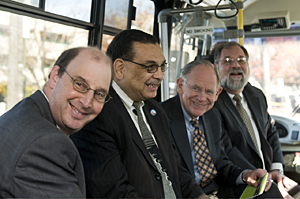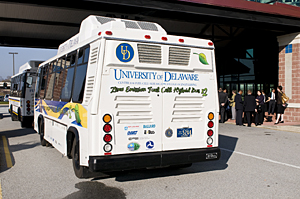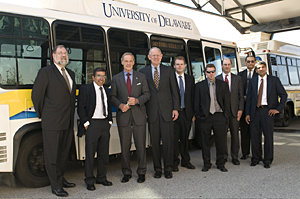
ADVERTISEMENT
- Rozovsky wins prestigious NSF Early Career Award
- UD students meet alumni, experience 'closing bell' at NYSE
- Newark Police seek assistance in identifying suspects in robbery
- Rivlin says bipartisan budget action, stronger budget rules key to reversing debt
- Stink bugs shouldn't pose problem until late summer
- Gao to honor Placido Domingo in Washington performance
- Adopt-A-Highway project keeps Lewes road clean
- WVUD's Radiothon fundraiser runs April 1-10
- W.D. Snodgrass Symposium to honor Pulitzer winner
- New guide helps cancer patients manage symptoms
- UD in the News, March 25, 2011
- For the Record, March 25, 2011
- Public opinion expert discusses world views of U.S. in Global Agenda series
- Congressional delegation, dean laud Center for Community Research and Service program
- Center for Political Communication sets symposium on politics, entertainment
- Students work to raise funds, awareness of domestic violence
- Equestrian team wins regional championship in Western riding
- Markell, Harker stress importance of agriculture to Delaware's economy
- Carol A. Ammon MBA Case Competition winners announced
- Prof presents blood-clotting studies at Gordon Research Conference
- Sexual Assault Awareness Month events, programs announced
- Stay connected with Sea Grant, CEOE e-newsletter
- A message to UD regarding the tragedy in Japan
- More News >>
- March 31-May 14: REP stages Neil Simon's 'The Good Doctor'
- April 2: Newark plans annual 'wine and dine'
- April 5: Expert perspective on U.S. health care
- April 5: Comedian Ace Guillen to visit Scrounge
- April 6, May 4: School of Nursing sponsors research lecture series
- April 6-May 4: Confucius Institute presents Chinese Film Series on Wednesdays
- April 6: IPCC's Pachauri to discuss sustainable development in DENIN Dialogue Series
- April 7: 'WVUDstock' radiothon concert announced
- April 8: English Language Institute presents 'Arts in Translation'
- April 9: Green and Healthy Living Expo planned at The Bob
- April 9: Center for Political Communication to host Onion editor
- April 10: Alumni Easter Egg-stravaganza planned
- April 11: CDS session to focus on visual assistive technologies
- April 12: T.J. Stiles to speak at UDLA annual dinner
- April 15, 16: Annual UD push lawnmower tune-up scheduled
- April 15, 16: Master Players series presents iMusic 4, China Magpie
- April 15, 16: Delaware Symphony, UD chorus to perform Mahler work
- April 18: Former NFL Coach Bill Cowher featured in UD Speaks
- April 21-24: Sesame Street Live brings Elmo and friends to The Bob
- April 30: Save the date for Ag Day 2011 at UD
- April 30: Symposium to consider 'Frontiers at the Chemistry-Biology Interface'
- April 30-May 1: Relay for Life set at Delaware Field House
- May 4: Delaware Membrane Protein Symposium announced
- May 5: Northwestern University's Leon Keer to deliver Kerr lecture
- May 7: Women's volleyball team to host second annual Spring Fling
- Through May 3: SPPA announces speakers for 10th annual lecture series
- Through May 4: Global Agenda sees U.S. through others' eyes; World Bank president to speak
- Through May 4: 'Research on Race, Ethnicity, Culture' topic of series
- Through May 9: Black American Studies announces lecture series
- Through May 11: 'Challenges in Jewish Culture' lecture series announced
- Through May 11: Area Studies research featured in speaker series
- Through June 5: 'Andy Warhol: Behind the Camera' on view in Old College Gallery
- Through July 15: 'Bodyscapes' on view at Mechanical Hall Gallery
- More What's Happening >>
- UD calendar >>
- Middle States evaluation team on campus April 5
- Phipps named HR Liaison of the Quarter
- Senior wins iPad for participating in assessment study
- April 19: Procurement Services schedules information sessions
- UD Bookstore announces spring break hours
- HealthyU Wellness Program encourages employees to 'Step into Spring'
- April 8-29: Faculty roundtable series considers student engagement
- GRE is changing; learn more at April 15 info session
- April 30: UD Evening with Blue Rocks set for employees
- Morris Library to be open 24/7 during final exams
- More Campus FYI >>
4:07 p.m., Nov. 16, 2009----The University of Delaware's newest bus, a 22-foot, 22-seat vehicle that runs on hydrogen, tooled around downtown Wilmington on Monday, Nov. 16, carrying some very important riders. U.S. Sen. Thomas R. Carper (D-Del.), U.S. Rep. Michael N. Castle (R-Del.) and Wilmington Mayor James Baker sat inside chatting about various options for transport in the region.
The ride was part of a briefing session to update Delaware's congressional delegation about the progress of UD's fuel cell research, research for which they secured $1.7 million in funding in 2007.
The paint job on the bus illustrates its place in the progression of fuel cell research at UD. It reads “Zero Emission Fuel Cell Hybrid Bus x2,” as the bus is the second in the hydrogen fleet; the first rolled out in 2007 and currently runs as a shuttle on UD's Newark campus.
Additionally, the “x2” relates to the fuel cell capacity of the bus. Where the first bus contained just one fuel cell stack, this bus houses two, making it more powerful and capable of reaching higher speeds.
The bus, like its predecessor, does not require diesel like traditional buses; instead its fuel cells combine hydrogen and oxygen to directly produce electricity to run the bus. The reaction produces no greenhouse gas emissions and its exhaust consists only of water and water vapor.
“There are only about a dozen fuel cell buses in service across our entire country and two of these buses are on UD's campus. I think we can be rightfully proud of that achievement,” said Ajay Prasad, professor of mechanical engineering, director of the UD Center for Fuel Cell Research and host of the event.
“These two fuel cell buses are a tremendous step forward,” said Castle. “The University has been a leader in this. We have pulled hard to try to help with the funding of it. We hope this expands exponentially from here on.”
Carper commented that the buses and the green economy they represent are where the country needs to be headed. “It will be reduce our dependence on foreign oil, cleaning up our environment, providing not only safe and affordable transportation but also a lot of jobs to drive them and a lot of jobs to build them, and that's a great combination,” he said.
U.S. Sen. Ted Kaufman (D-Del.) is traveling out of the country and could not make it to the event, but sent a representative and his best wishes.
“This is just another example of Delaware setting an example for all states. This fuel cell bus highlights the fantastic work that University of Delaware's Fuel Cell Research Lab is doing,” Kaufman said in a statement. “Developing this technology in Delaware will be a boon to our state's economy and reaffirm our position as a leader in cutting edge technology.”
Mark Barteau, senior vice provost for research and strategic initiatives at UD, noted this and other projects undertaken by researchers working within the University of Delaware Energy Institute aim to be solutions to the world's complex energy problems.
“When we launched the Energy Institute, one of the things we said we wanted to do was to take research out of the laboratory and into public demonstration, and I think that's a critical component of our fuel cell bus program,” Barteau said. “This is very much out there on the street where our students can use it and the public can see it.”
While the buses are visible all around campus, what might be hidden is all the work that goes into making them possible.
“We have about 20 people currently working on these projects,” said Michael Chajes, dean of the UD College of Engineering. “It's critical for our nation to both do the research but also educate the people who will carry this forward.”
Chajes remarked that in order to do that important work, UD needs more facilities, stating the planned Interdisciplinary Science and Engineering building will allow for more of this sort of innovation.
Article by Andrea Boyle
Photos by Evan Krape




